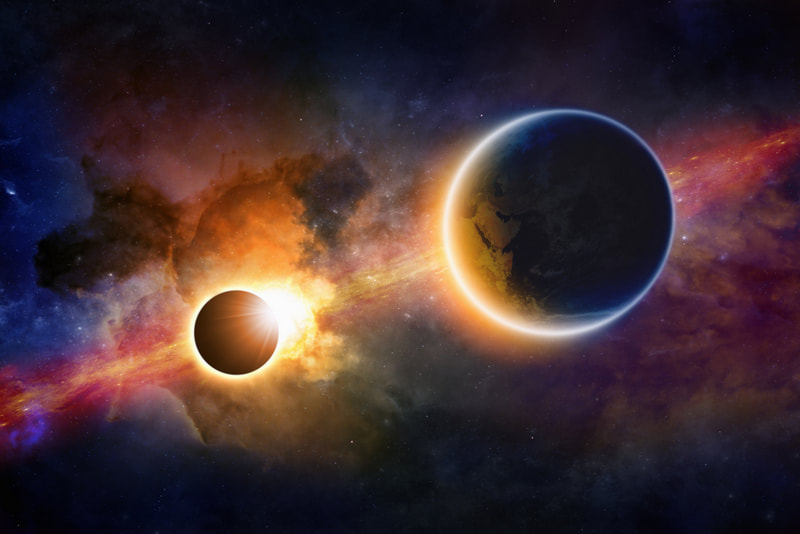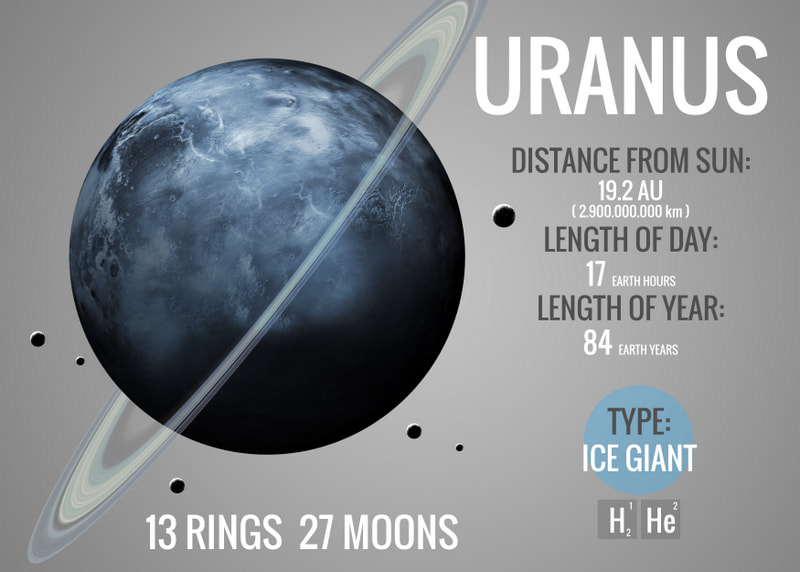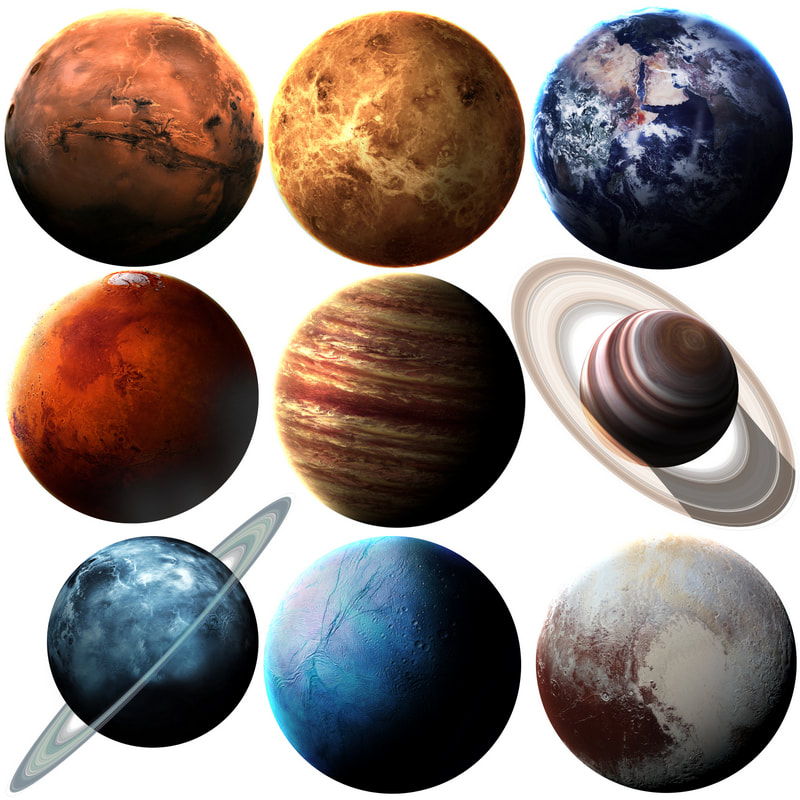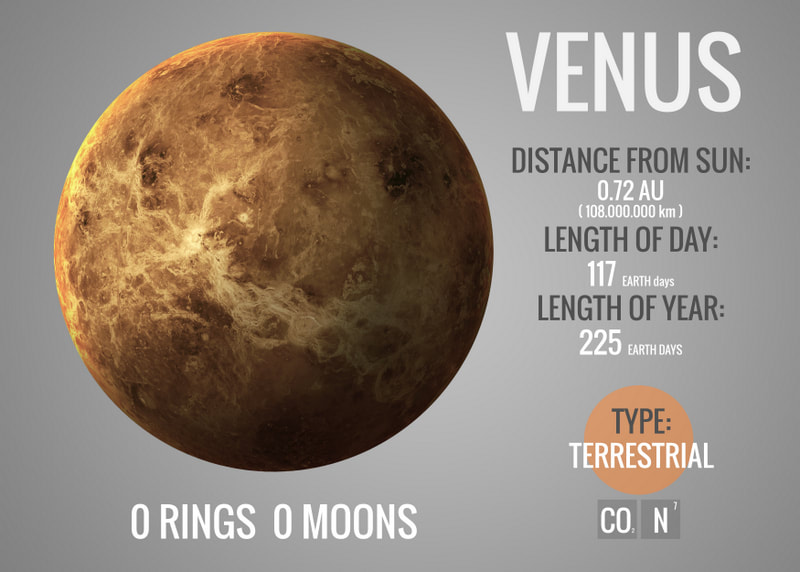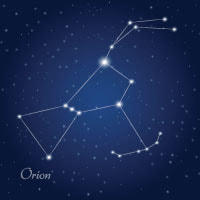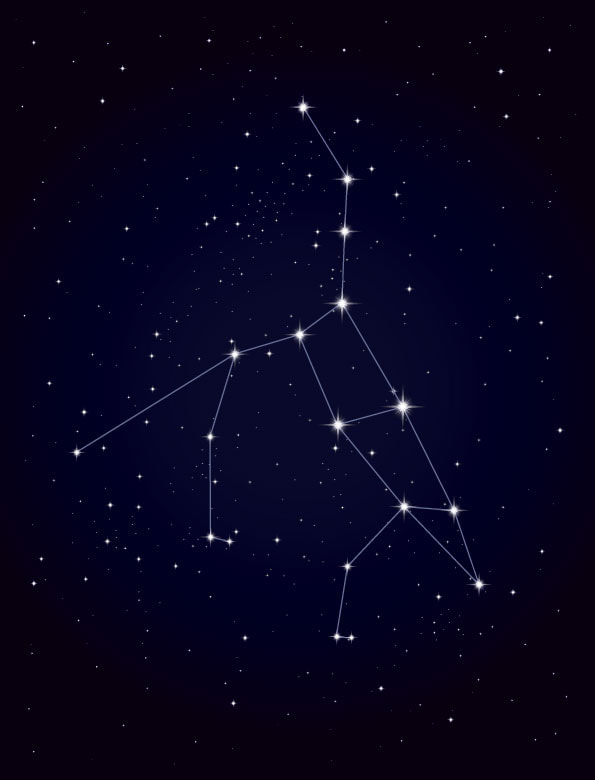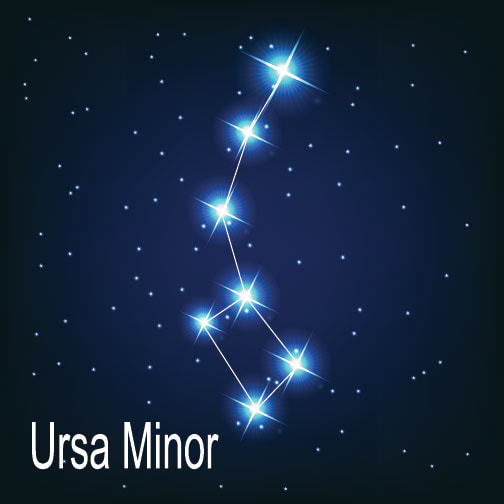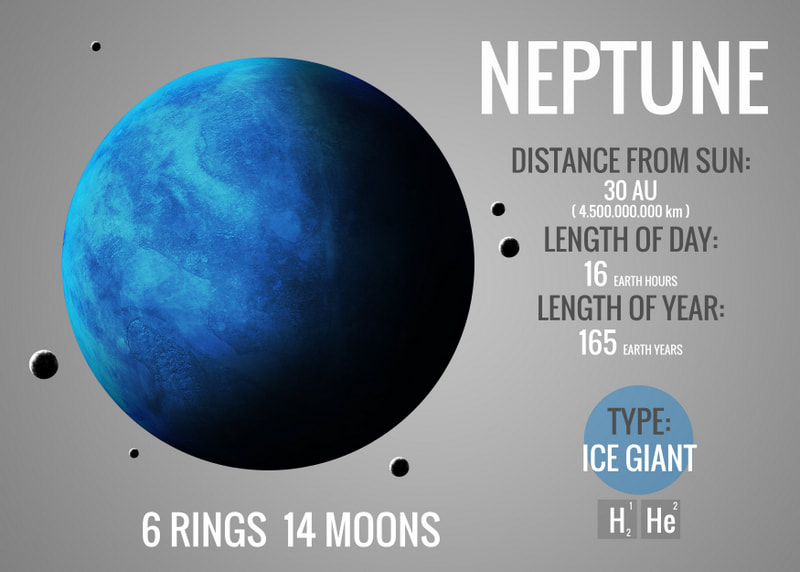‘planet’, as defined by the International Astronomical Union (IAU) in 2006, is:
A planet is a celestial body that
(a) is in orbit around the Sun,
(b) has sufficient mass for its self-gravity to overcome rigid body forces so that it assumes a hydrostatic equilibrium (nearly round) shape, and
(c) has cleared the neighborhood around its orbit.
The planets of our solar system are presented over the next few pages.
A planet is a celestial body that
(a) is in orbit around the Sun,
(b) has sufficient mass for its self-gravity to overcome rigid body forces so that it assumes a hydrostatic equilibrium (nearly round) shape, and
(c) has cleared the neighborhood around its orbit.
The planets of our solar system are presented over the next few pages.
Here are some interesting facts about the planets of our Solar System.
- In order from the smallest to the largest, the planets rank: Mercury, Mars, Venus, Earth, Neptune, Uranus, Saturn and Jupiter.
- Earth and Venus are very similar in size, with Venus having a diameter of 12,104km and Earth of 12,742km. They are the planets closest in size to each other.
- The further away from the Sun the planet is, the longer it takes to orbit. Mercury and Venus take 88 days and 225 days respectively. Earth, of course, takes what we know as one year, 365.26 days. Mars takes 1.9 years to orbit the Sun, while Jupiter takes 11.9 years, Saturn 29.5 years and Uranus 84.0 years. Neptune, the furthest from the Sun, takes 164.8 years to orbit the Sun!
- Neptune is the coldest planet, while Venus is the hottest.
- Neptune, Uranus, Saturn and Jupiter have rings.
- The four planets closest to the Sun, Mercury, Venus, Earth and Mars, are known as terrestrial planets, known by their dense composition, while the four furthest away are known for their gaseous composition, and called gas giants.
Facts about Mercury
Mercury is gravitationally locked to the Sun, which has slowed down its rotation, to match the speed of its Orbit around the Sun. It completes three rotations on its axis as it completes an orbit.
Mercury is named after the messenger to the gods, Mercury, from Roman lore. This is thought to be because of the quick orbiting speed.
The first mention of the planet found is around 3000BC by the Sumerian people of Mesopotamia. Other early civilizations believed the planet was two different stars, one appearing in the morning and the other in the evening, because it made its orbit so quickly. It was first considered a planet in 1543, the year Copernicus released the Solar System with the Sun at the center for the first time. Previously, Western scientists thought the other planets and the Sun orbited around Earth.
Mercury has only 28% of the gravity Earth has. This is why it has no moons or rings, as it cannot keep any objects close with the force of gravity.
Mercury is the second densest planet, Earth being the first. It consists mainly of rock and heavy metals.
Mercury is gravitationally locked to the Sun, which has slowed down its rotation, to match the speed of its Orbit around the Sun. It completes three rotations on its axis as it completes an orbit.
Mercury is named after the messenger to the gods, Mercury, from Roman lore. This is thought to be because of the quick orbiting speed.
The first mention of the planet found is around 3000BC by the Sumerian people of Mesopotamia. Other early civilizations believed the planet was two different stars, one appearing in the morning and the other in the evening, because it made its orbit so quickly. It was first considered a planet in 1543, the year Copernicus released the Solar System with the Sun at the center for the first time. Previously, Western scientists thought the other planets and the Sun orbited around Earth.
Mercury has only 28% of the gravity Earth has. This is why it has no moons or rings, as it cannot keep any objects close with the force of gravity.
Mercury is the second densest planet, Earth being the first. It consists mainly of rock and heavy metals.
Facts about Venus
From Earth, Venus is the second brightest object in the sky, even visible on a clear, bright day. The only object more visible from Earth is the moon.
Ancient civilizations thought that Venus was two stars, the ‘morning star’ and the ‘evening star’. These were known as Lucifer and Vesper by the ancient Romans, and Phosphorus and Hesperus by the ancient Greeks. It was originally thought they were two stars because when the orbit of Venus over take the orbit of Earth, it becomes visible at sunset, rather than sunrise.
Venus rotates very slowly on its axis, meaning it takes 243 Earth days to complete one day on Venus (one rotation). This means that a day on Venus is longer than a year on Venus – a Venus year being equivalent to 225 Earth days, and a Venus day being equivalent to 243 Earth days!
Venus was known by the Babylonians as the ‘bright queen of the sky’, and is named after the Roman goddess of beauty and love.
From Earth, Venus is the second brightest object in the sky, even visible on a clear, bright day. The only object more visible from Earth is the moon.
Ancient civilizations thought that Venus was two stars, the ‘morning star’ and the ‘evening star’. These were known as Lucifer and Vesper by the ancient Romans, and Phosphorus and Hesperus by the ancient Greeks. It was originally thought they were two stars because when the orbit of Venus over take the orbit of Earth, it becomes visible at sunset, rather than sunrise.
Venus rotates very slowly on its axis, meaning it takes 243 Earth days to complete one day on Venus (one rotation). This means that a day on Venus is longer than a year on Venus – a Venus year being equivalent to 225 Earth days, and a Venus day being equivalent to 243 Earth days!
Venus was known by the Babylonians as the ‘bright queen of the sky’, and is named after the Roman goddess of beauty and love.
The rotation of the Earth is gradually getting slower, but at an almost imperceptible rate – 17 milliseconds every 100 years. It will take 140 million years before a day will be 25 hours instead of 24.
Earth, with its nickel-iron core and rapid rotation, has a powerful magnetic field. This powerful field protects us from solar wind. It is also the densest planet in the Solar System.
Scientists in ancient times believed that the Earth was center of the universe, thinking that other planets and galaxies orbited around it. In reality, there is only one natural satellite of Earth, which is the moon.
Earth, with its nickel-iron core and rapid rotation, has a powerful magnetic field. This powerful field protects us from solar wind. It is also the densest planet in the Solar System.
Scientists in ancient times believed that the Earth was center of the universe, thinking that other planets and galaxies orbited around it. In reality, there is only one natural satellite of Earth, which is the moon.
Facts about Mars
There have been around 40 missions of all types (landers, orbiters, rovers etc) to Mars, but only 18 have been successful.
The tallest mountain in our Solar System, with a 21km height and 600km diameter, Olympus Mons in a shield volcano on Mars. It formed through billions of years, but there is evidence or recent flows of volcanic lava, leading scientists to believe it might still be active.
Dust storms in Mars are extreme, covering the entire planet and lasting for months.
There have been some incidences of the atmosphere from Mars falling to Earth in the form of meteorites. Scientists estimate these pieces of Mars were ejected, and spent millions of years before crashing to Earth.
Mars has been known as many names throughout different cultures. The ancient Egyptians knew it as ‘Her Desher’ – ‘the red one’, while ancient Chinese astronomers called it ‘the fire star’. The ancient Greeks used the name of their god of war, Ares, for the planet, and the Romans followed suit with the name Mars.
Mars gets its red color because the rocks and dust which cover it have a high iron content.
There have been around 40 missions of all types (landers, orbiters, rovers etc) to Mars, but only 18 have been successful.
The tallest mountain in our Solar System, with a 21km height and 600km diameter, Olympus Mons in a shield volcano on Mars. It formed through billions of years, but there is evidence or recent flows of volcanic lava, leading scientists to believe it might still be active.
Dust storms in Mars are extreme, covering the entire planet and lasting for months.
There have been some incidences of the atmosphere from Mars falling to Earth in the form of meteorites. Scientists estimate these pieces of Mars were ejected, and spent millions of years before crashing to Earth.
Mars has been known as many names throughout different cultures. The ancient Egyptians knew it as ‘Her Desher’ – ‘the red one’, while ancient Chinese astronomers called it ‘the fire star’. The ancient Greeks used the name of their god of war, Ares, for the planet, and the Romans followed suit with the name Mars.
Mars gets its red color because the rocks and dust which cover it have a high iron content.
Facts about Jupiter
Of all the planets, Jupiter has the shortest day of 9 hours and 55 minutes, while it has a year of 11.8 Earth years.
There is a Great Red Spot, a storm on Jupiter, that has been going on for 350 years. The size of the storm is more than three times larger than the Earth.
Jupiter has a ring system and multiple moons. The rings are mostly made of dust particles. There are at least 67 moons orbiting Jupiter, the largest of which is Ganymede, which is larger in size than the planet Mercury.
Jupiter has a very large atmosphere made of hydrogen. Its interior is made of compressed layers of hydrogen gas, then metallic liquid hydrogen. The core is made up of rock, ice and metals.
Of all the planets, Jupiter has the shortest day of 9 hours and 55 minutes, while it has a year of 11.8 Earth years.
There is a Great Red Spot, a storm on Jupiter, that has been going on for 350 years. The size of the storm is more than three times larger than the Earth.
Jupiter has a ring system and multiple moons. The rings are mostly made of dust particles. There are at least 67 moons orbiting Jupiter, the largest of which is Ganymede, which is larger in size than the planet Mercury.
Jupiter has a very large atmosphere made of hydrogen. Its interior is made of compressed layers of hydrogen gas, then metallic liquid hydrogen. The core is made up of rock, ice and metals.
Facts about Saturn
Saturn is the flattest planet, not quite a perfect sphere. Its equatorial diameter is larger than its polar diameter. This is because the planet has a low density, and turns on its axis very quickly, with a 10 hour and 34 minute day.
A year in Saturn is the equivalent of 29.4 years on Earth.
Saturn has an atmosphere divided into layers of clouds, the top layers being ammonia ice, the next layers of water ice and the lower layers of sulfur ice and cold hydrogen. Around the north pole, there are hexagonal patterns of clouds and a vortex, like a hurricane storm, over its south pole.
Saturn is made almost completely of hydrogen, the layers getting denser and denser the further inside the planet you go. Close to the hot core, the hydrogen is in metallic form.
Saturn’s rings are comprised of dust and chunks of ice, and the planet has 150 moons.
Saturn is the flattest planet, not quite a perfect sphere. Its equatorial diameter is larger than its polar diameter. This is because the planet has a low density, and turns on its axis very quickly, with a 10 hour and 34 minute day.
A year in Saturn is the equivalent of 29.4 years on Earth.
Saturn has an atmosphere divided into layers of clouds, the top layers being ammonia ice, the next layers of water ice and the lower layers of sulfur ice and cold hydrogen. Around the north pole, there are hexagonal patterns of clouds and a vortex, like a hurricane storm, over its south pole.
Saturn is made almost completely of hydrogen, the layers getting denser and denser the further inside the planet you go. Close to the hot core, the hydrogen is in metallic form.
Saturn’s rings are comprised of dust and chunks of ice, and the planet has 150 moons.
Facts about Neptune
Neptune was first observed by modern science in 1846, and is named after the god of the sea of the ancient Romans.
Neptune itself has a heavy atmosphere of mostly hydrogen and helium, and is made of helium, methane and hydrogen gases. Water, methane ice and ammonia are also present, while the core of the planet is rock. It is the small amount of methane in the atmosphere that absorbs red light and makes the planet look blue.
Neptune has rings made of dust and ice particles, and 14 moons.
It has an active climate, with large storms and high speed winds.
Neptune was first observed by modern science in 1846, and is named after the god of the sea of the ancient Romans.
Neptune itself has a heavy atmosphere of mostly hydrogen and helium, and is made of helium, methane and hydrogen gases. Water, methane ice and ammonia are also present, while the core of the planet is rock. It is the small amount of methane in the atmosphere that absorbs red light and makes the planet look blue.
Neptune has rings made of dust and ice particles, and 14 moons.
It has an active climate, with large storms and high speed winds.
Pluto, which was named after the Greek god of the underworld, was reclassified, stripped of its planet status and becoming classed as a dwarf planet, in 2006. Originally it had been discovered in 1930 by Clyde Tombaugh, and had been considered the ninth planet without question until 1992.
In 1992, the discovery of several objects of a similar size to Pluto in the Kuiper belt, made astronomers question its planethood. In 2005, Eris was discovered, and it was 27% more massive than Pluto (though smaller in volume, making it the second largest dwarf planet in our solar system). Because of its mass, scientists initially perceived Eris to be larger than Pluto, which led them to re-evaluate and formally define the term ‘planet’. The International Astronomical Union (IAU) designated Eris and Pluto as dwarf planets in 2006, as they did not meet the new criteria
The definition given, which stated that the planet ‘must have cleared the neighborhood around its orbit’, excluded Pluto, so the former planet was put in the category of a ‘dwarf planet’. However, many astronomers refute this new classification.
In 1992, the discovery of several objects of a similar size to Pluto in the Kuiper belt, made astronomers question its planethood. In 2005, Eris was discovered, and it was 27% more massive than Pluto (though smaller in volume, making it the second largest dwarf planet in our solar system). Because of its mass, scientists initially perceived Eris to be larger than Pluto, which led them to re-evaluate and formally define the term ‘planet’. The International Astronomical Union (IAU) designated Eris and Pluto as dwarf planets in 2006, as they did not meet the new criteria
The definition given, which stated that the planet ‘must have cleared the neighborhood around its orbit’, excluded Pluto, so the former planet was put in the category of a ‘dwarf planet’. However, many astronomers refute this new classification.

